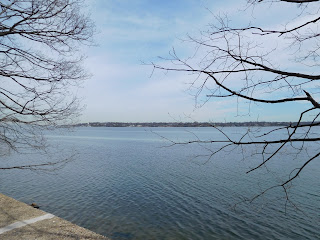Sometimes, when I surf the web, I am swept into a stream of flotsam from bikes past.
If you ride road bikes, something about this brake may seem familiar to you. And well it should.
Here is an example of what I mean:
 |
| Photo by berangberang |
If you ride road bikes, something about this brake may seem familiar to you. And well it should.
It was made by Altenberger in the German Federal Republic (West Germany to us Americans) during the 1970's. I started working in bike shops during that time, and some bikes--mainly lower-priced ones with upright handlebars--came with that brake.
It's the ancestor of brakes found on nearly every road bike built since the mid-1990's. Why? Take a look at those bolts with the red nylon washers. They make it a dual-pivot brake. While they may not have been the original of the genre, they were the first dual-pivots to appear on any significant numbers of bikes.
They were supposed to provide the simplicity and light weight of sidepulls but the "symmetry" and modulation of centerpulls. Unfortunately, Altenberger's brake didn't exhibit any of those qualities. I think that it had to do with the fact that the arm with the cable anchor bolt usually overlapped the pivot on the other arm, as you see in the photo. That eliminated whatever "symmetry" the brake may have been designed to have, and made for very uneven braking.
Perhaps even more to the point, the brake was not of very good quality. The metal used in the arms was pretty flexy. (The fact that the arms were long didn't help matters.) The rather flimsy spring would lose its springiness fairly quickly, which further diminished the brake's power and modulation.
After Altenberger stopped making this brake (or went out of business altogether: I don't recall seeing very many of the company's brakes after the early '80's or so), Weinmann produced a similar model, which they called the "Synchron". Its quality and aesthetics were better than those of the Altenberger, but, like its predecessor, the Synchron never synchronized very well and got worse over time.
So, when Shimano came out with their own version of the dual-pivot brakes, I cringed. Younger cyclists didn't have memories of the earlier dual-pivot brakes, so they were enthusiastic about this new "innovation". I refrained from them for a few years until someone with whom I shared, at that time, a similar riding style and whose ideas I respected convinced me to try a pair of the Shimano 600/Ultegra dual-pivots. Although I was, at first, put off by their gray epoxy finish as I was by the fact they were dual-pivots, I became a convert. Shimano figured out how to actually make the arms work in harmony and used better quality materials than the ones found in the Altenberger or Synchron. Even the lower-priced Tektros, not to mention the higher-end Mavic and Campagnolo Record and Chorus
dual-pivot brakes, are worlds better than those early attempts to combine the advantages and eliminate the weaknesses of center- and side-pull brakes found on ten-speeds of the 1970's and earlier.






































